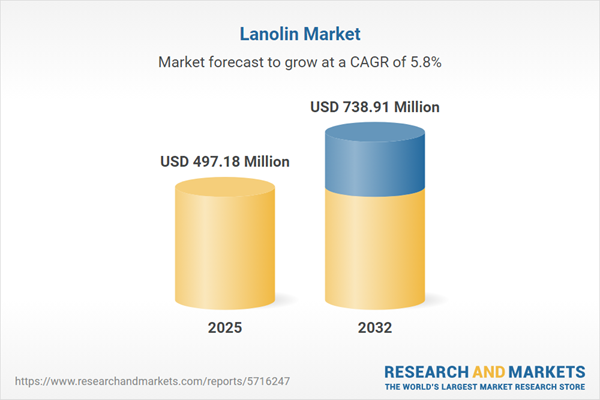Speak directly to the analyst to clarify any post sales queries you may have.
The lanolin market is experiencing pivotal transformation as sustainability, advanced processing, and regulatory shifts reshape how leading organizations pursue growth and mitigate emerging risks. Senior decision-makers face a complex landscape of ethical sourcing, compliance, and supply chain innovation.
Market Snapshot: Lanolin Market Size and Growth Outlook
The lanolin market is projected to expand from USD 470.32 million in 2024 to USD 497.18 million in 2025 and reach USD 738.91 million by 2032, representing a compound annual growth rate (CAGR) of 5.80%. Demand for high-purity lanolin, increased adoption of sustainable extraction technologies, and heightened focus on ethical sourcing practices provide a foundation for sector expansion. Major manufacturers are rolling out innovations in material science and advancing their global supply chain capabilities to address both regulatory requirements and emerging commercial opportunities. As competition intensifies, regulatory agility and the ability to withstand disruptions in sourcing and distribution have emerged as critical differentiators for industry participants.
Scope & Segmentation: Comprehensive Lanolin Industry Overview
- Applications: Lanolin continues to play a key role in cosmetics and personal care for baby care, haircare, skincare, and color cosmetics by enhancing product performance and consumer experience. The food segment leverages lanolin for improved texture and shelf life in bakery, dairy, confectionery, and beverage products. Industrial applications, such as lubricants, metalworking fluids, textiles, and leather finishing, rely on lanolin's chemical properties to address technical requirements. Pharmaceutical usage spans human and veterinary segments across over-the-counter and prescription products for added formulation flexibility.
- Product Types: The market addresses broad needs through crude lanolin and derivatives, including lanolin acid, alcohol, and multiple ester forms. Modified lanolin—available as hydrous, anhydrous, and purified grades—serves sensitive formulations across cosmetics, industrial, and medical segments.
- Forms: Lanolin is offered in liquid, powder, and solid states to ensure optimal compatibility with various industry requirements and manufacturing processes.
- Distribution Channels: A mix of offline retail, direct B2B sales, and global e-commerce channels ensures broad regional access for customers and aligns with the changing preferences of both established and emerging markets.
- Geographical Coverage: The analysis spans the Americas, Europe, the Middle East and Africa, and the Asia-Pacific, highlighting growth trends in regions such as China, India, Japan, Australia, South Korea, and Southeast Asian economies.
- Industry Players: Key companies reviewed include Croda International Plc, BASF SE, The Lubrizol Corporation, KLK OLEO Sdn. Bhd., Vantage Specialty Chemicals Inc., Evonik Industries AG, Stearineries Dubois SAS, Lucas Meyer Cosmetics Inc., Gattefossé SAS, and Q1 Group Inc., with a focus on strategic positioning and industry impact.
Key Takeaways: Strategic Insights for Decision-Makers
- Premium personal care and advanced pharmaceutical markets are leading innovation by integrating high-purity lanolin, enabling products with differentiated consumer benefits and enhanced therapeutic profiles.
- The adoption of advanced extraction, such as enzymatic and low-impact processes, is steadily reducing environmental footprints and enabling new, specialized end-uses within high-value market segments.
- Sustainability initiatives give priority to animal welfare, introduce responsible sourcing frameworks, and leverage blockchain for verifiable supplier transparency and traceability along the supply chain.
- Regulatory changes in quality assurance mandate stricter analytical and validation standards, especially for solvent and allergen controls, prompting adjustments to operational protocols in manufacturing and compliance teams.
- Digital transformation is accelerating data-driven procurement and supply chain risk assessment through artificial intelligence and predictive analytics, allowing for adaptive operational decisions as market variables shift.
Tariff Impact: Navigating U.S. Trade Dynamics
Adjustments to the United States tariff schedule are reshaping global lanolin trade flows and prompting suppliers to reevaluate sourcing and processing strategies. In response, manufacturers are expanding domestic processing and diversifying regional sourcing to maintain market engagement. The use of bonded warehousing is increasing to secure uninterrupted supply and navigate evolving tariff frameworks, resulting in more localized and resilient supply chains.
Methodology & Data Sources
This report is grounded in a robust multi-phase methodology. Comprehensive desk research covers relevant industry literature, regulatory documentation, and expert publications. Primary data is gathered through interviews with technical and formulation specialists worldwide. Structured data triangulation and analytic frameworks provide reliable and actionable findings for sector leaders.
Why This Report Matters
- Equips executive teams with actionable insights into lanolin technology, compliance, and emerging market trends critical for effective strategic and operational planning.
- Delivers targeted competitive intelligence and benchmarking to identify supply chain strengths and vulnerabilities within the sector.
- Supports alignment on innovation, responsible sourcing, and regulatory standards, enabling organizations to adapt to industry transformation with confidence.
Conclusion
The lanolin market is positioned at a turning point shaped by new sustainability standards, evolving extraction processes, and significant trade shifts. This comprehensive analysis empowers senior leaders to make informed decisions and develop business strategies built for resilience and future growth.
Additional Product Information:
- Purchase of this report includes 1 year online access with quarterly updates.
- This report can be updated on request. Please contact our Customer Experience team using the Ask a Question widget on our website.
Table of Contents
3. Executive Summary
4. Market Overview
7. Cumulative Impact of Artificial Intelligence 2025
List of Figures
Samples

LOADING...
Companies Mentioned
The key companies profiled in this Lanolin market report include:- Croda International Plc
- BASF SE
- The Lubrizol Corporation
- KLK OLEO Sdn. Bhd.
- Vantage Specialty Chemicals, Inc.
- Evonik Industries AG
- Stearineries Dubois SAS
- Lucas Meyer Cosmetics, Inc.
- Gattefossé SAS
- Q1 Group, Inc.
Table Information
| Report Attribute | Details |
|---|---|
| No. of Pages | 197 |
| Published | October 2025 |
| Forecast Period | 2025 - 2032 |
| Estimated Market Value ( USD | $ 497.18 Million |
| Forecasted Market Value ( USD | $ 738.91 Million |
| Compound Annual Growth Rate | 5.8% |
| Regions Covered | Global |
| No. of Companies Mentioned | 11 |









